Protective Glazing
Tobit Curteis and Naomi Luxford
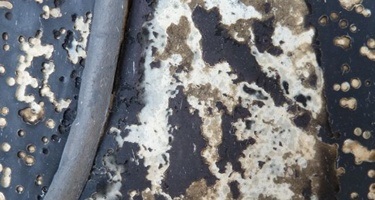 |
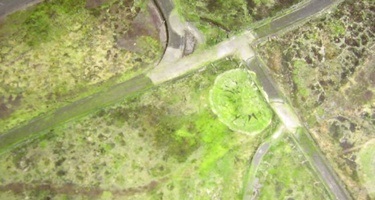 |
||
| The effects of moisture: left, pitting caused by the dissolution of soluble components (Photo: Tobit Curteis Associates) and, right, microbiological growth (Photo: Holy Well Glass) | |||
Despite its fragile and brittle nature, stained glass has survived in many churches and cathedrals from as early as the 12th century. Often it is the last vestige of the rich colourful decoration that covered walls, fittings and furnishings in the medieval church interior, and early examples are of huge significance. Unlike other works of art, stained glass also forms an integral part of the structure and envelope of the building. As such, it is of particular importance that stained glass of all periods should be conserved in situ wherever possible, an approach which often requires the use of protective glazing.
As part of an initiative to improve the understanding of protective glazing systems, a detailed research project commissioned by the Building Conservation and Research Team at English Heritage is currently under way.
DETERIORATION
Seen from a distance inside a church, historic stained glass can look remarkably well preserved. However, distance and transmitted light often disguise problems which are only apparent on much closer inspection. Medieval stained glass, and some later painted decoration, are often chemically unstable as a result of the materials and techniques used to create them. In particular, the leaching of potassium and sodium ions from the glass in the presence of water can cause severe physical deterioration of the glass body. Stained glass windows are also subjected to wind-loading which can damage the entire structure. The risk of vandalism and deliberate damage add further weight to the arguments for protecting the exterior face in particular.
In addition, the internal face can be damaged by repeated high levels of condensation, which facilitate the dissolution of soluble compounds within the glass paint and body causing pitting. Differential thermal stresses can lead to delamination of paint and enamel layers. High levels of condensation can also lead to substantial microbiological growth on the surface of the glass. Not only can this growth be disfiguring but it can also retain moisture and the physical and chemical side-effects of the lifecycle of the organisms can cause further damage.
OPTIONS FOR PROTECTION
Although there are a number of ways of protecting stained glass from physical damage and vandalism, for example the use of wire mesh, the only system which can control chemical and environmental deterioration in situ is protective glazing.
Protective glazing has a long history: it was used at York Minster from 1856 and Lindena church in Germany from as early as 1796. However, the benefits of this approach were first recorded during the 1960s in Bern Minster in Switzerland, where some of the stained glass had been reinstalled in frames behind new glazing after the war. These were in noticeably better condition than the panels that had been reinstalled in their original positions, which were unprotected.
Protective glazing is now widely used to conserve important and vulnerable stained glass. However, just as no two windows or churches are the same, no two protective glazing systems are the same. As a result it has been difficult to determine the best design features for specific installations.
CURRENT PRACTICE
Protective glazing involves the installation of a layer of new glass on the exterior of the window. In some cases the historic glass is left in situ, while in others it is moved forward (towards the interior) on a metal support with the new glazing installed in the original grooves in the tracery. In most cases the gap between the original glass and the protective glazing is ventilated at the top and bottom, which allows air to pass through the interspace between the two. Some systems are vented to the outside (externally ventilated), some to the inside (internally ventilated) and some combine the two.
In some cases sealed units that are more similar to double glazing have been used. However, due to the difficulty in creating an effective seal, significant condensation can occur and this approach is now rare. Most current protective glazing is internally ventilated, allowing the historic glass to be surrounded by air from within the building, which also, generally, has the advantage of lower levels of pollution.
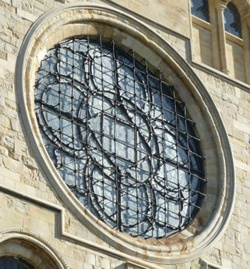 |
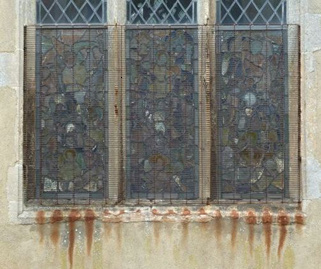 |
|
| New protective glazing in the south oculus window at Canterbury Cathedral, partially obscured by the heavy structural armature and grille | Poorly designed and badly maintained grilles obscure the exterior of a stained glass window, and (below) shadows cast by a grille disfigure the image inside (Both photos: Tobit Curteis Associates) |
AESTHETICS
One of the main concerns with the use of protective glazing is its impact on the appearance of the building. A wide variety of approaches can be considered to modify the external appearance of the protective glazing, including glass type, glass surface treatment, and whether the glazing is constructed in panels or is leaded to imitate the original glass and mounting.
However, change in appearance is nothing new. Corroding 20th-century metal mesh is often tolerated because it appears always to have been there. Increasing opacity and distortion of the original glass is tolerated because it occurs gradually. However, both cause at least the same level of visual impact as protective glazing when viewed externally. Internally, the shadows cast by grilles are particularly damaging to the appreciation of works of art.
PREVIOUS RESEARCH
Over the past 40 years research has been carried out, mostly in France and Germany, into the efficacy of different protective glazing systems. Between 2002 and 2005 an EU-funded project (VIDRIO – see Recommended Reading) studied protective glazing in a number of churches and cathedrals across Europe. This project looked at how windows were ventilated, the amount and duration of condensation periods, pollution levels within the interspace, and temperature changes.
There was a wide variation in the windows tested in terms of the geometry of the window, the size of the air vents and the depth of the interspace. VIDRIO reported that the size of the interspace and dimensions of the air vent were fundamental elements for the ventilation of protective glazing. However, there were no firm guidelines on what sizes were critical when designing protective glazing.
The VIDRIO research also showed that glass corrosion is accelerated by prolonged exposure to liquid moisture from condensation, as well as by high levels of gaseous pollution. For unstable glasses these effects are increased as the glass develops cracks allowing pollutants and moisture to continue to penetrate beneath the surface.
ENGLISH HERITAGE RESEARCH
Because of the limited research data available on specific design details, environmental effects and the aesthetic impact of protective glazing, there is considerable difficulty for conservators, advisory bodies and clients in evaluating the benefits or drawbacks for specific installations, in particular in parish churches.
In order to provide the necessary information to allow informed discussions to take place, in 2012 English Heritage commissioned a research programme to look at both the technical and aesthetic issues involved and, in particular, questions relating to energy efficiency. This included a detailed literature study to establish the current state of understanding (including translation of key materials), computational fluid dynamic modelling to assess how specific design details affect functionality, and environmental monitoring and evaluation of existing and new protective glazing systems, to provide a better understanding of actual installations. The research programme is expected to be completed in 2015 with the results published both in academic journals and as an English Heritage advisory document.
 |
|
| The ventilation gap at the base of an internally ventilated system: in this example the stained glass has been left in the original glazing grooves and the base of the glass tilted forward to allow airflow, with a similar gap at the top. (Photo: Holy Well Glass) |
PRELIMINARY RESULTS
The preliminary results of the research have demonstrated that protective glazing provides significant benefits to vulnerable stained glass. In almost all cases it provides protection against physical damage, windloading and direct rainfall.
For internally ventilated systems, the range of temperature fluctuations can be significantly reduced due to the thermal buffering provided by the protective glazing. The lowest temperature values on the historic glass are generally maintained at a higher level than on the unprotected glass; this reduces the dew point temperature and so minimises condensation. In most welldesigned installations, condensation is entirely prevented on the historic glass. Condensation continues to occur on the modern glass but the flow of air through the interspace ensures that any condensation rapidly evaporates.
The reduction in condensation on the internal face of the historic glass reduces deterioration associated with both dissolution of the soluble components of the glass and failure of the paint and enamel layers. In addition it has a direct and significant effect in reducing microbiological growth.
Research on grisaille glass has shown that reducing the range of rapid temperature change is particularly important for glass with applied layers of paint or enamel (in grisaille work, designs are generally painted onto the face of predominantly ‘white’ glass in blacks and greys). In these types of glass, large and rapid temperature changes can lead to stresses developing at the boundary between the applied layers and the body glass, resulting in delamination and flaking.
Many of these benefits were also observed on externally ventilated systems, although they were found to be less efficient, providing a lower level of protection. Externally ventilated systems have the additional disadvantage that they can allow wind-driven rain to enter the interspace through the ventilation openings.
One much-repeated concern regarding protective glazing has been that it reduces rainwater washing of the historic glass surface, leading to the build up of dirt and pollutants, including particles that retain water. While surface washing will be prevented, protective glazing has been shown to lead to lower levels of particulates and gaseous pollution. This indicates that the loss of the washing effect is unlikely to be critical.
Data collected from many UK sites has demonstrated that even an inefficient system of secondary glazing can offer significant protection, minimising the impact of external factors such as wind and rain and greatly reducing internal condensation.
MATHEMATICAL MODELLING
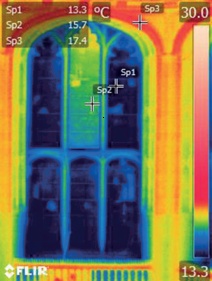 |
|
| Thermographic image showing heat loss though a stained glass window and the thermal buffering effect of the protective glazing fitted to the upper centre light (Photo: Tobit Curteis Associates) | |
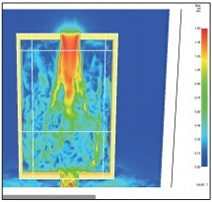 |
|
| Computational fluid dynamics modelling to assess how design options affect air flow and performance (Photo: Element Energy) |
With the aid of computational fluid dynamics, a computer simulation of protective glazing systems has been created to identify the key thermal performance features and phenomena. This has shown that the air vents should ideally be placed at the very top and bottom of the glazing to maximise airflow. However, air vents on the front face can still be effective if they are properly sized.
To promote optimal airflow the air vents at the top and bottom should also be equally sized and distributed as evenly as possible across the width of the glazing. While larger vents improve interspace airflow – and therefore thermal buffering – the improvement slows when the ratio of vent area to interspace area (measured horizontally) exceeds 30 per cent as turbulence increases. The use of fine wire mesh and other materials covering vents also decreases efficiency of airflow so an unrestricted vent size of 25-30 per cent is desirable.
Further modelling of realistic geometries for stained glass windows with protective glazing, such as small and large lancet windows and tracery lights, is planned. This should also further test different air vent geometries and different interspace depths.
ENERGY EFFICIENCY
Previous research into the energy efficiency benefits of ventilated protective glazing has been limited. Studies in the USA on the use of storm windows with clear glass have shown a significant reduction in heat loss, even when the units have some air infiltration. While these systems do not achieve the same levels of heat- loss reduction as sealed secondary glazing or double glazing units, an increase in efficiency of up to 80 per cent is commonly observed. The use of low-emissivity glass can also have a significant effect in reducing heat loss.
However, the amount of glazing in a church or cathedral relative to the amount of masonry, is likely to remain the critical parameter in terms of how much heat is lost via the envelope and therefore the extent to which protective glazing can improve overall thermal efficiency. Nevertheless, in a church with extensive glazing, the impact could be significant.
OUTCOMES
The extensive environmental monitoring data from protective glazing systems in a number of UK case study sites confirmed previous published findings and provided a more detailed understanding of how different systems function. The research outcomes will draw together these findings with the results from previous studies in Europe and will provide detailed information on the benefits of protective glazing. Together with the mathematical modelling, the analysis will enable an overview of the critical design features for protective glazing systems and will help to identify which features of the design are most significant in building efficient systems. The aesthetic impact and functional performance of protective glazing can then be evaluated against the deterioration of the stained glass.
The information will be available as a guidance document from English Heritage for conservation practitioners and advisors as well as those charged with the care of historic stained glass.
~~~
Recommended Reading
D Anderson, ‘Stained Glass and Its Decay’, The Conservation and Repair of Ecclesiastical Buildings, Cathedral Communications Limited, Tisbury, 1996
M Bambrough, ‘Aesthetic Protective Glazing’, Historic Churches, Cathedral Communications Limited, Tisbury, 2005
F Becherini et al, ‘Thermal Stress as a Possible Cause of Paintwork Loss in Medieval Stained Glass Windows’, Studies in Conservation, 53, 2008
A Bernardi et al, ‘Conservation of Stained Glass Windows with Protective Glazing’, Journal of Cultural Heritage, 14, 2013
Corpus Vitrearum Medii Aevi: Medieval Stained Glass in Great Britain, conservation section
RHM Godoi et al, ‘The Shielding Effect of the Protective Glazing of Historical Stained Glass Windows’, Atmospheric Environment, 40, 2006
T Husband et al (eds), The Art of Collaboration: Stained Glass Conservation in the 21st Century, Harvey Miller, Washington, 2010



